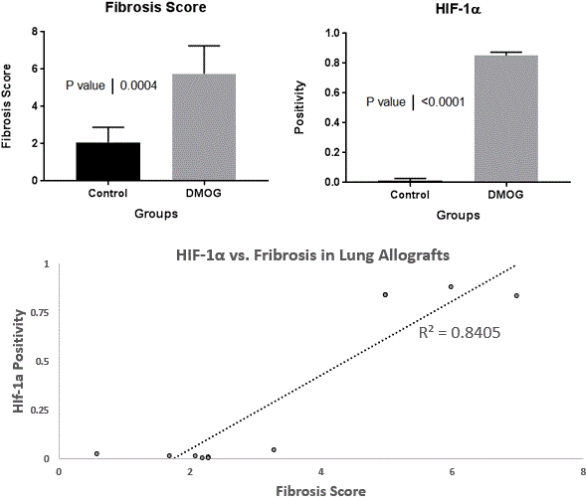Long-Term HIF-1α Stabilization is Associated with Fibrosis in Rat Lung Allografts
1Duke Transplant Center, Duke University, Durham, NC
2Medical University of South Carolina, Charleston, SC.
Meeting: 2018 American Transplant Congress
Abstract number: A38
Keywords: Fibrosis, Histology, Lung transplantation, Rat
Session Information
Session Name: Poster Session A: Biomarkers, Immune Monitoring and Outcomes
Session Type: Poster Session
Date: Saturday, June 2, 2018
Session Time: 5:30pm-7:30pm
 Presentation Time: 5:30pm-7:30pm
Presentation Time: 5:30pm-7:30pm
Location: Hall 4EF
Introduction: HIF-1α is a subunit of a heterodimeric transcription factor hypoxia-inducible factor 1 (HIF-1) and functions as a master transcriptional regulator of cellular and developmental response to hypoxia. Recent in vitro work suggests chronic activation of the HIF pathway may lead to tissue fibrosis. DMOG is a cell permeable, competitive inhibitor of prolyl hydroxylase domain-containing proteins (PHDs), which stabilizes HIF-1α levels in the cell. Our goal was to examine whether long-term upregulation of HIF-1α via DMOG administration was associated with the development of fibrosis and chronic rejection in lung transplantation.
Methods: Orthotopic left lung transplants from male Wistar–Kyoto rats into F344 rats were performed. Control animals received cyclosporine (i.m., 5mg/kg; n=7) while experimental group (n=4) received DMOG (i.p., 40mg/kg) with cyclosporine (i.m., 5 mg/kg) every other day for 8 weeks post-transplant. Fibrosis was assessed by a blinded pathologist using a modified Ashcroft scale. Image analysis was done using Aperio ImageScope (v12.3.0.5056) between control animals and recipients and between native lung tissue and allograft.
Results: HIF-1α was significantly higher in the DMOG treated group compared to controls (Figure 1: 1.29% vs. 85.14%, p<0.0001). Mean fibrosis score was significantly higher in the DMOG treated group compared to the controls (Figure 1: 2.07 vs. 5.75, p=0.0004). Total HIF-1α expression correlated strongly with fibrosis score (Figure 1: R2=0.856). Intimal hyperplasia was significantly higher in the DMOG treated allografts compared to native lung (6.55% vs. 28.67%, p=0.0046).
Conclusions: HIF-1α is associated with increased fibrosis in rat lung allografts. Thus, long-term upregulated HIF-1α may serve as a mediator or biomarker of chronic rejection. Further work is needed to determine whether this potential tool may be used in a clinical model.
CITATION INFORMATION: Freischlag K., Ezekian B., Schroder P., Everitt J., Yoon J., Swiderska-Syn M., Parker W., Diehl A., Kwun J., Knechtle S. Long-Term HIF-1α Stabilization is Associated with Fibrosis in Rat Lung Allografts Am J Transplant. 2017;17 (suppl 3).
To cite this abstract in AMA style:
Freischlag K, Ezekian B, Schroder P, Everitt J, Yoon J, Swiderska-Syn M, Parker W, Diehl A, Kwun J, Knechtle S. Long-Term HIF-1α Stabilization is Associated with Fibrosis in Rat Lung Allografts [abstract]. https://atcmeetingabstracts.com/abstract/long-term-hif-1-stabilization-is-associated-with-fibrosis-in-rat-lung-allografts/. Accessed December 14, 2025.« Back to 2018 American Transplant Congress

